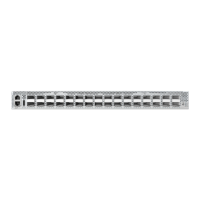C
HAPTER
14
| Basic Administration Protocols
Simple Network Management Protocol
– 363 –
CONFIGURING
SNMPV3 GROUPS
Use the Administration > SNMP (Configure Group) page to add an SNMPv3
group which can be used to set the access policy for its assigned users,
restricting them to specific read, write, and notify views. You can use the
pre-defined default groups or create new groups to map a set of SNMP
users to SNMP views.
CLI REFERENCES
◆ "show snmp group" on page 642
PARAMETERS
These parameters are displayed in the web interface:
◆ Group Name – The name of the SNMP group to which the user is
assigned. (Range: 1-32 characters)
◆ Security Model – The user security model; SNMP v1, v2c or v3.
◆ Security Level – The following security levels are only used for the
groups assigned to the SNMP security model:
■
noAuthNoPriv – There is no authentication or encryption used in
SNMP communications. (This is the default security level.)
■
AuthNoPriv – SNMP communications use authentication, but the
data is not encrypted.
■
AuthPriv – SNMP communications use both authentication and
encryption.
◆ Read View – The configured view for read access.
(Range: 1-64 characters)
◆ Write View – The configured view for write access.
(Range: 1-64 characters)
◆ Notify View – The configured view for notifications.
(Range: 1-64 characters)
Table 22: Supported Notification Messages
Model Level Group
RFC 1493 Traps
newRoot 1.3.6.1.2.1.17.0.1 The newRoot trap indicates that the sending
agent has become the new root of the
Spanning Tree; the trap is sent by a bridge
soon after its election as the new root, e.g.,
upon expiration of the Topology Change Timer
immediately subsequent to its election.
topologyChange 1.3.6.1.2.1.17.0.2 A topologyChange trap is sent by a bridge
when any of its configured ports transitions
from the Learning state to the Forwarding
state, or from the Forwarding state to the
Discarding state. The trap is not sent if a
newRoot trap is sent for the same transition.

